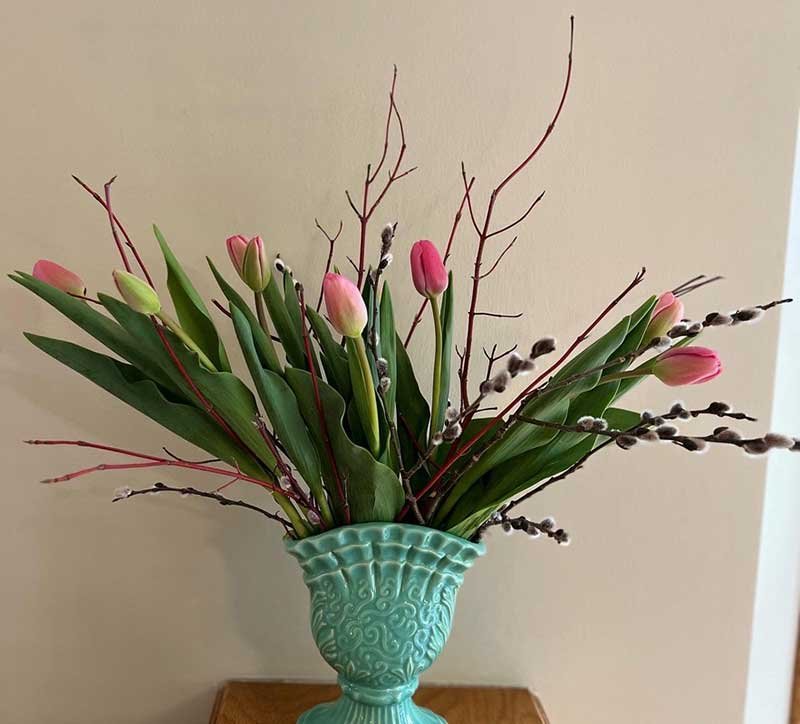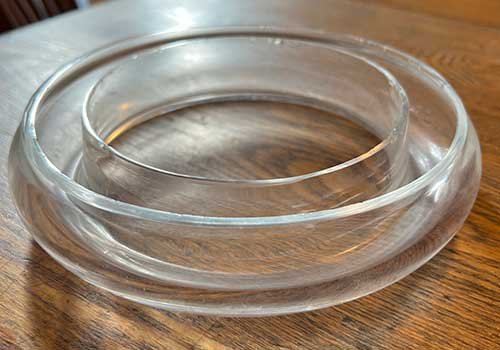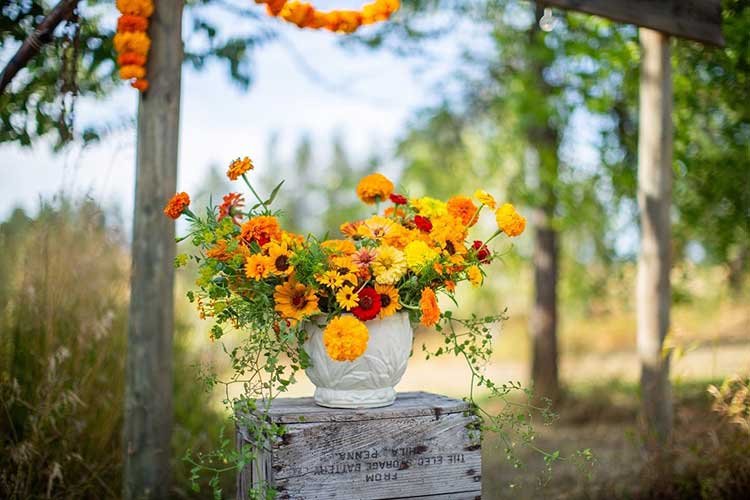Hold it
All humans need a connection to nature on a deep spiritual level. We’re wired for it. We crave it, and bringing fresh flowers into our homes is one of the best ways to make that connection.
The containers you choose for that bit of nature in your living space are an equally important piece of the design as the flowers themselves. Sometimes, I start with a container as my inspiration before I even think about the flowers.
One of my favorite vases that has a little foot to elevate it and provide an architectural structure as a contrast to the organic shapes of the flowers.
You won’t be surprised to learn that I’ve been collecting containers for years and it’s a lot of fun to choose just the right one for the job.
I want to inspire you to think about the creative containers you can use for your floral designs. You might be surprised to find that you already own all kinds of vessels that you never thought about as a vase. If nothing else, this list will give you things to look for when you go junking.
Here’s an abbreviated list of container types and just a few ways to think about them differently.
1 Baskets
If you can tuck a water source inside a basket, you have an instant innovative container that is every bit as much of the design as the flowers.
If the basket is going to be a table top arrangement and won’t be moved, you can just cluster the inside with a series of jam jars filled with water. Tuck your stems in and be sure to hide the jars with foliage or a bit of moss. Done.
If the basket will be moved or carried, like a flower girl basket, you can soak a piece of oasis foam in water, tuck it in a plastic bag inside the basket and design away. If you want to use something more environmentally sustainable, you can go with an Oshun Pouch or wrap the stems in eco wraps. Any of those solutions will be fine for an event like a wedding where the flowers only need to last a day.
Flowers secured in oasis foam inside a plastic bag are ready to withstand vigorous flower girl swinging
2 Bud vases
Bud vases are small vases with narrow openings designed to showcase a single flower. I love the simplicity of a single stem because it is a chance to zero in on detail and practice the basics. You don’t have to “arrange” anything because you just put the stem in. But, you are still making lots of decisions - the right bud vase for the right flower, stem length, how does the color of the bloom play off the color of the vase? There are many mini aesthetic decisions making the detail of bud vases lots of fun.
If you want to take it to another level, group a few of them together to make a vignette.
One of my favorite hand made bud vases really animates these poppies
3 Tulipiere
Sometimes called a fan vase - these vessels have a narrow envelope of an opening that is much wider than the base. They are ideal for tulips because they really show off the beauty in each individual stem. The vase naturally adds movement and gives space for the tulips to stretch and snake around into dynamic patterns.
In the pictures below you can see an antique glass one that I’ve had since forever - it’s filled with tulips every spring. The ceramic one belongs to my mother and is freshly filled with stems that will still stretch color up and open more over time.
Tulipieres are actually a design from the 17th century from the Dutch tulip craze. It is made of stackable containers with narrow necked openings for individual stems. The pieces are put together into a pagoda shape that is just as dominant in the design as the tulips themselves. I haven’t got one but they are cool and, as a confirmed tulip addict, I’m on the lookout for one.
My favorite “fan vase” for tulips is from the 1930s
My mother’s fan vase. You can see that the opening is a narrow slot like an envelop that directs the flow of the design quite naturally
4 Pansy rings
In the flower world, we can get a bit obsessed with stem length. But, there are so many gorgeous little blooms that naturally have short stems. It is easy to pop those shorties into these charming little rings for an instant centerpiece. There is even room for a candle in the middle of the ring to dress it up even more.
Pansies are right in the name, so that’s a no brainer. But you really can put in anything. I love to make a wild living wreath with sweet peas and their curly vines, you could fill it with floofly dahlias to make something a little more extravagant. How about wild violets and grape hyacinth in the spring? Have fun experimenting with one on your table so you can share your meals with flowers every day.
A vintage ceramic pansy ring from my own collection. This one has a little structure on the top to hold hard to handle stems in place.
A simple glass pansy ring. It is great for making the structure of a wreath shape and can be completely covered by foliage and flowers spilling over the side. The low profile makes it perfect for a centerpiece.
5 Repurposed table ware
Anything that holds water is fair game. I love to repurpose tureens, soup bowls and serving dishes to make extra fancy centerpieces at holiday time. Don’t be intimidated by the wide opening. We can hide all kids of structures inside to support the stems like a ball of chicken wire, a little floral tape forming a grid across the top, or old fashioned flower frogs.
This antique vegetable tureen from my great aunt has gold details and a low profile making it a favorite vessel for a centerpiece on our Christmas table.
6 Junk Shop Finds
I picked up this white stoneware bowl at a flea market many years ago. I’m not sure what it’s original purpose was, but it’s one of my favorite containers for dramatic arrangements.
7 French Flower buckets
Tall galvanized metal buckets are classics in French flower shops. Designed to showcase displays of a single variety, they make fun oversized vases for long stems and bigger blooms. They have a classic rustic charm that I like to use for dramatic displays on buffets. They are pretty easy to source new, but the older ones are always a happy find. This particular one was a gift from a dear friend who found it in a second hand shop in Spokane. It’s a fave.
7 Flower Bricks
Just as the name implies a flower brick is a square or rectangle shape with holes in the top. Clear acrylic ones are really popular right now for making low floral runners on long tables. There are some really cool antique ceramic bricks out there if you know what to look for.
I have this ceramic house made by local artist Casey Doyle that is a playful riff on the style. The vase itself is so great - it gives me a head start on success. You just put flowers in the holes and it’s instantly fabulous. I like to make it wild but you could cover the roof with a carpet of dense blooms or add trailing vines. It’s all fun all the time.
You can put as much creativity into containers as you do with flowers. This time of year, when there aren’t many flowers to be had, it’s fun to look around your house for design inspiration later in the season and to do a little junking to see what you can find. Have fun.










